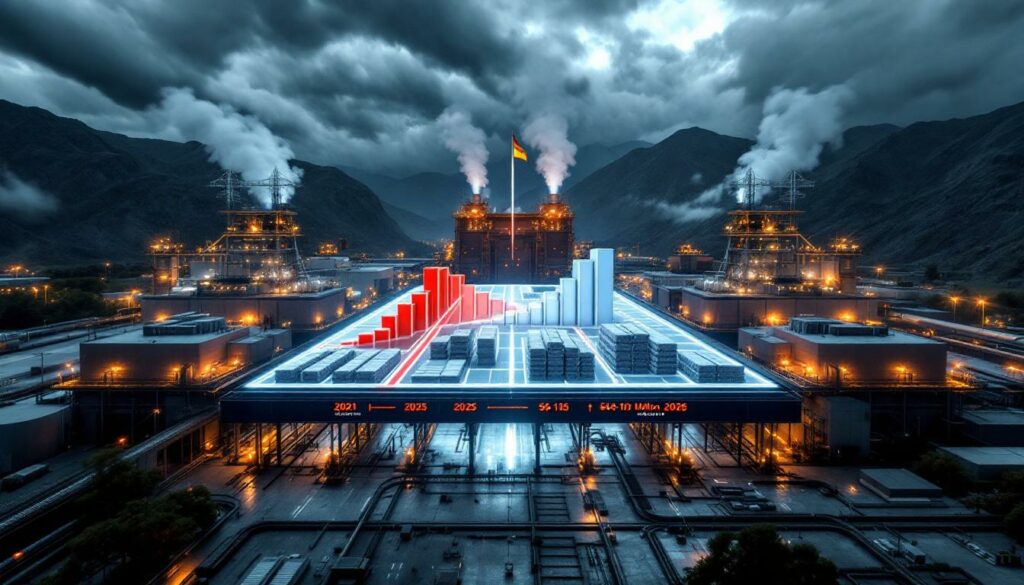San Ciprian Smelter Crisis: Alcoa's Spain Aluminium Facility Faces Prolonged Shutdown
The aluminium industry faces another setback as one of Europe's significant production facilities remains offline longer than anticipated. Alcoa's troubled San Ciprian aluminium smelter in Spain, already curtailed since 2021, now confronts further delays in its restart plans following a catastrophic power outage earlier this year.
What Happened to Alcoa's San Ciprian Aluminium Smelter?
The San Ciprian aluminium facility in northwestern Spain has become emblematic of the challenges facing Europe's energy-intensive industries. Originally curtailed in 2021 due to skyrocketing electricity costs, the facility had been preparing for a carefully orchestrated restart under new operational leadership.
In March 2025, Alcoa formed a strategic joint venture with Ignis Equity Holdings specifically to navigate the complex restart process for the troubled facility. The partnership aimed to leverage Ignis's expertise in renewable energy development alongside Alcoa's smelting operational knowledge to create a more sustainable operational model.
However, these carefully laid plans were dramatically disrupted on April 28, 2025, when Spain experienced a nationwide power blackout that severely impacted both the San Ciprian aluminium smelter and its adjacent alumina refinery. The outage caused significant technical complications that have forced a complete reassessment of the restart timeline.
Technical Challenges Following the Blackout
Industry experts familiar with aluminium smelting technology explain that power outages are particularly damaging to smelting operations. When electricity supply is interrupted to electrolytic cells (pots) containing molten cryolite and alumina, the material can quickly solidify, requiring extensive and costly repairs before operations can resume.
"Once an aluminium pot line 'freezes' due to power loss, restarting becomes exponentially more complicated than regular maintenance. Complete rebuilding of affected cells is often necessary," notes a metallurgical engineering assessment cited in the Mining Weekly report.
This technical reality has created cascading complications for Alcoa's restart plans, extending far beyond the immediate impact of the April outage.
What Are the Financial Implications of the Delay?
The financial consequences of this extended curtailment have now been quantified by Alcoa, revealing substantial impacts on the company's near-term financial outlook.
Alcoa has publicly disclosed that it expects to record a net loss ranging from $90 million to $110 million in 2025 directly attributable to the San Ciprian smelter delays. This translates to a significant per-share impact of $0.35 to $0.42, including pre-tax and non-controlling interest factors.
Looking ahead to 2026, the financial strain will continue as Alcoa projects that cash used in operations related to the San Ciprian facility will amount to between $110 million and $130 million. These figures underscore the severe financial burden the company faces from maintaining an idle facility of this scale.
Comparative Context of Financial Impact
These projected losses represent a substantial drain on Alcoa's resources, particularly considering the company's efforts to optimize its global production portfolio. The San Ciprian situation now stands as one of the most significant financial challenges in Alcoa's European operations.
For investors and market analysts, these financial projections highlight how a single facility experiencing prolonged curtailment can materially impact even a global producer's overall financial performance. Such situations have become increasingly common due to ongoing mining consolidation trends affecting resource companies worldwide.
When Will the San Ciprian Smelter Resume Operations?
The timeline for bringing this significant production capacity back online has been substantially revised. According to Alcoa's latest announcement, the company now expects to complete the restart of the San Ciprian aluminium smelter by mid-2026 at the earliest.
This represents a significant extension from earlier projections and means the facility will remain offline for approximately five years since its initial curtailment in 2021 – an extraordinarily long period in the aluminium industry.
Critical Prerequisites for Restart
Alcoa and joint venture partner Ignis Equity Holdings have implemented a strategic pause in restart preparations. Before committing additional resources, they are seeking specific assurances from the Spanish government regarding two critical factors:
- A comprehensive explanation of the causes behind the April 28 nationwide power blackout
- Verifiable guarantees about the reliability of Spain's national power grid moving forward
These conditions reflect the fundamental reality that aluminium smelting operations require absolutely consistent and reliable electricity supply. Even momentary interruptions can cause catastrophic damage to production equipment.
What Is the Strategic Importance of the San Ciprian Facility?
The San Ciprian complex represents a significant production asset within both Alcoa's global portfolio and Europe's aluminium production landscape.
Production Capabilities and Integration
The site encompasses two complementary operations:
- An alumina plant with annual capacity of 1.5 million tonnes
- An aluminium smelter capable of producing 228,000 tonnes annually
This integrated structure allows for significant operational efficiencies when functioning properly. The alumina plant not only supplies the adjacent smelter but also serves other Alcoa operations and external customers across diverse sectors.
According to Mining Weekly's reporting, the alumina produced at San Ciprian supplies not just metallurgical applications but also serves non-metallurgical sectors including:
- Ceramics manufacturing
- Chemical production
- Water purification systems
Regional Economic Significance
The facility's extended curtailment extends beyond corporate balance sheets to impact the broader economy of Spain's Galicia region. As a major employer and economic driver in northwestern Spain, the facility's operational status directly affects:
- Local employment opportunities
- Regional tax revenues
- Supporting businesses in the industrial supply chain
- Spain's overall industrial production capacity
How Does This Delay Reflect Broader Industry Challenges?
The ongoing struggles at San Ciprian highlight several fundamental challenges facing the global aluminium industry, particularly in Europe.
Energy Dependency Vulnerabilities
Aluminium production ranks among the most energy-intensive industrial processes globally. The primary smelting process requires enormous, uninterrupted electricity supply – approximately 13,500-15,000 kWh per tonne of aluminium produced.
This extreme energy intensity creates inherent vulnerabilities:
- Price Volatility Risk: Even moderate fluctuations in electricity costs can dramatically impact production economics
- Supply Stability Requirements: Unlike many industries that can adapt to occasional energy interruptions, aluminium smelting requires absolute continuity
- Grid Dependency: Facilities rely completely on robust national grid infrastructure, making them vulnerable to system-wide failures
The San Ciprian situation exemplifies how this energy dependency creates operational challenges even for well-established facilities operated by experienced global producers. Furthermore, the growing trend toward electrification in mining across the resource sector is placing additional demands on power infrastructure globally.
European Competitiveness Concerns
Beyond Alcoa's specific challenges, the San Ciprian situation represents part of a troubling trend affecting European industrial capacity in energy-intensive sectors:
- Multiple European aluminium smelters have faced curtailment or closure pressures in recent years
- The region's energy prices often exceed those of competing regions like the Middle East, North America, and China
- Grid reliability concerns add another layer of operational risk unique to aging infrastructure systems
These factors collectively raise questions about the long-term viability of energy-intensive manufacturing in Europe without significant policy and infrastructure interventions. The situation also highlights growing concerns about European critical minerals supply security across the continent.
What Are the Market Implications of the Continued Curtailment?
The extended offline status of the San Ciprian facility has meaningful implications for aluminium markets, particularly within Europe.
Supply Chain Disruptions
With 228,000 tonnes of annual production capacity remaining offline longer than anticipated, market participants must adapt their supply arrangements. This substantial volume represents approximately 5% of Europe's primary aluminium production capacity.
The continued curtailment particularly affects:
- Downstream fabricators relying on regional supply
- Transportation logistics (shipping volumes and routes)
- Warehouse inventory management strategies
Pricing Dynamics
While global aluminium prices are primarily determined by macro factors like Chinese production levels and overall economic demand, regional premiums can be significantly influenced by local supply constraints.
The extended San Ciprian curtailment could contribute to:
- Sustained European aluminium premiums over LME base prices
- Increased reliance on imports from other regions
- Modified contract structures to account for supply uncertainty
For buyers and traders of physical aluminium in Europe, the continued absence of San Ciprian's production capacity remains a relevant factor in market assessments. For investors watching the sector, this situation presents potential investment opportunities insights as market dynamics continue to evolve.
FAQ About Alcoa's San Ciprian Smelter Situation
What caused the initial curtailment of the San Ciprian smelter?
The smelter was initially curtailed in 2021 due to exceptionally high power prices that made operations economically unsustainable. Aluminium production's extreme electricity requirements (approximately 14,000 kWh per tonne) make it particularly vulnerable to energy price spikes, which Europe experienced dramatically in 2021.
Who is operating the San Ciprian facility now?
Since March 2025, the smelter has been operated through a joint venture between Alcoa and Ignis Equity Holdings. This partnership was specifically formed to facilitate the restart process by combining Alcoa's operational expertise with Ignis's energy management capabilities.
What is the total production capacity of the San Ciprian site?
The integrated San Ciprian complex includes:
- An alumina plant with annual capacity of 1.5 million tonnes
- An aluminium smelter with annual capacity of 228,000 tonnes
What assurances is Alcoa seeking from the Spanish government?
Before proceeding with restart efforts, Alcoa and its joint venture partner are seeking:
- A comprehensive explanation regarding the cause of the April 28 nationwide power outage
- Specific guarantees concerning the future reliability of Spain's national power grid
These assurances are critical given the catastrophic impact even brief power interruptions can have on aluminium smelting operations.
How does the San Ciprian situation compare to other European smelters?
The San Ciprian facility's challenges reflect broader pressures facing European aluminium production. Several other European smelters have faced similar curtailments or capacity reductions due to energy cost pressures and grid reliability concerns in recent years.
What alternatives do European aluminium buyers have?
With San Ciprian's capacity offline, European consumers must secure alternative supply through:
- Increased imports from the Middle East, Russia, or other producing regions
- Greater reliance on European recycled (secondary) aluminium
- Long-term contract adjustments with remaining European primary producers
Industry Outlook and Long-Term Considerations
The San Ciprian situation raises important questions about the future of energy-intensive industrial production in Europe. As the continent pursues ambitious decarbonization goals while simultaneously facing energy security challenges, facilities like San Ciprian exist at the intersection of competing priorities.
The eventual resolution of this specific situation may provide valuable insights into how Europe will balance industrial competitiveness, energy security, and environmental objectives in the coming decades. According to analysts following industry evolution trends, the Alcoa and Spain aluminium smelter delay represents just one example of the broader challenges facing resource industries globally.
Disclaimer: This analysis contains forward-looking statements regarding Alcoa's operations and financial projections. Actual results may differ materially from these projections due to various factors including energy market developments, regulatory changes, and broader economic conditions.
Ready to Capture the Next Major Mineral Discovery?
Don't miss life-changing investment opportunities in the resources sector—explore Discovery Alert's dedicated discoveries page to see how the proprietary Discovery IQ model identifies significant ASX mineral discoveries before the broader market, giving subscribers an immediate edge with real-time, actionable alerts.




